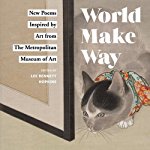Edited by Lee Bennett Hopkins
Poetry Picture Book
For ages 7 and up
Abrams, 2018, 978-1-4197-2845-7
Every person sees a work of art differently. Some may
notice the forms in the artwork, while others may be captivated by the colors.
Some may only see the story that the artwork seems to be telling, and others
may be drawn to examine how the artwork was created in the first place.
Everyone’s reaction to the work is therefore different and unique.
In this splendid
book nineteen poets have created poems that were inspired by works of art that
are on display at the Metropolitan Museum of Art. The first of these is a
portrait by Gustav Klimt. In it we see a girl in a white dress looking at us.
Her hands are behind her back and there is an air of impatience about her.
Certainly this emotion conveyed itself to Marilyn Singer. In her poem Paint Me we hear the voice of the girl
who wants Klimt to “Hurry up and / paint me.” She has things to do and,
furthermore, she is tired of the dress with its flowers. She is ready to be on
the move; it is time for the world to “make way,” for her and her restless
energy.
For the painting
Dancing in Columbia, Alma Flor Ada
has written the poem Dancing. The
narrators are the musicians in the painting, seven of them in all, who take up
so much space that there is room for only two dancers. The man and women are
“absorbed in our music” and their attention is such that “everything else is
forgotten.”
In Cat Watching a Spider we see an image of
a cat watching a little spider scuttle across the floor. The cat is hunched,
its attention fixed on the little animal. The poem that Julie Fogliano has
written about this wonderful artwork perfectly captures, in just a few words,
the moment that we are witnessing. We feel the pause that brings the cat to a place
of stillness that is unusual in one who is often a creature of “prowl and
prance / and teeth and claws.”
Winslow Homer’s
painting Boys in a Dory made the poet
Charles Ghigna think of early evening when movement is slow and where the boys
in the boat “float as in a dream, / soft and serene.”
It is
fascinating to see how the poets featured in this collection reacted to the
artwork. Sometimes readers will see what they saw and perhaps feel what they
felt, and sometimes the poet’s ‘take’ on the artwork will be a surprise. We
will pause and take in their perspective and marvel at the way in which
perception can be so different from person to person, and so interesting. At
the back of the book the editor includes information about the poets who
contributed to the book. He also tells us about the artists, whose work is
featured on the pages.


